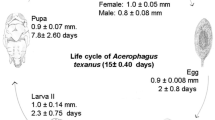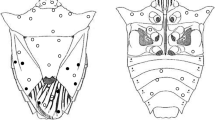Abstract
Various aspects of the morphology, life cycle and several natural enemies of Heteronygmia dissimilis, a lymantriid defoliator of African mahogany, Khaya nyasica, were studied in Morogoro, Tanzania. This insect is a multivoltine species with at least four overlapping generations a year, all stages of which can be found from March to October. November to February are apparently spent in pupal aestivation. The September/October generation completed its life cycle from egg to adult in an average of 41 and 45 days for males (five moults) and females (six moults), respectively. On the average females produced 200 eggs. Larvae occurred in two colour variations. They are generally nocturnal feeders, skeletonizing leaflets while in the early instars and resting on foliage or bark during the day. Adults exhibit sexual dimorphism in terms of size, colour and shape. The sex factor was close to 0.5. Four species of hymenopterous parasites belonging to four families (Chalcidae, Encyrtidae, Eurytomidae and Ichneu-monidae), as well as two species of dipterous parasites (Tachinidae) were obtained from eggs, prepupae and pupae of H. dissimilis. During the rainy season, the entomopathogenic fungus Paecilomyces farinosus was epidemic among pupae.
Résumé
Des aspects variés de la morphologie, du cycle biologique et de plusieurs ennemis naturels d’Heteronygmia dissimilis (Lymantriidae), insect phyllophage de l’acajou d’Afrique, Khaya nyasica, ont été étudiées à Morogoro, Tanzanie. Cet insect est une espe`ce d’au moins quatre générations par an, dont toutes les phases evolutives peuvent être observées de Mars à Octobre. De Novembre à Fevrier, l’insect apparaît dormant dans son état de pupe. En Novembre/Octobre la génération complétait son cycle biologique, soit de l’état d’oeuf à l’état adulte dans une moyenne de 41 jours (avec cinq mues) et 45 jours (avec six mues) respectivement pour les mâles et pour les femelles. En moyenne les femelles produisaient 200 oeufs. Les larves apparaissaient en deux colorations. En général, dans leurs premiers stades de développement les larves se nourissent pendant la nuit sur des folioles dont elles dévorent presque le tout à l’exception des veines majeures. Pendant la journée elles se reposent sur le feuillage ou sur l’écorce. p ]Les adultes montrent un dimorphisme sexuel accentué quant à la taille, la couleur et la forme. Le sexe ratio était près de 0.5. Quatre espéces parasites d’hymenoptères (Chalcidae, Encyrtidae, Eurytomidae et Ichneumonidae) ainsi que deux espèces de diptères (Tachinidae) ont été obtenues a partir des oeufs, prepupes et pupes d’H. dissimilis. Pendant la saison pluvieuse le champignon entomophyte Paecilomyces farinosus était épidemique parmi les pupes.
Similar content being viewed by others
References
Anonymous (1950/51) The mahogany shootborer, Hypsipyla albipartialis. Rep. For. Dep. Uganda. Kampala.
Anonymous (1981) Techniques Rurales en Afrique. Mémento du forestier. Ministère de la Cooperation et du Développement, République Française.
Ballard E. (1914) Two pests of mahogany in Nyasaland. Bull. ent. Res. 5, 61–62.
Brown A. H. S. and Smith G. (1957) The genus Paecilomyces Bainier and its perfect stage Byssochlamys Westling. Trans. Brit, my col Soc. 40, 17–89.
Bussche G. H. von Dem (1984) Establishment of hardwood plantations for the production of furniture and joinery timber in the Transvaal. Proc. IUFRO Sympos. Site and Productivity Fast Growing Plantations. Pretoria and Pietermaritzburg, South Africa. Vol. 2, 819–829.
Collenette C. L. (1955) A key to the African genera of Lymantriidae (Lepidoptera). Trans. R. ent. Soc. London 107, 187–197.
Dall’Asta U. (1975) Mission entomologique du Musée Royal de l’Afrique Centrale aux Monts Uluguru, Tanzania. 8. Lepidoptera Heterocera Lymantriidae. Rev. Zool Afr. 89, 734–736.
Doane C. C. and McManus M. L. (eds.) (1981) The gypsy moth: research toward integrated pest management. U.S. For. Serv., Tech. Bull 1584.
Evans H. C., (1982) Entomogenous fungi in tropical forest ecosystems: an appraisal. Ecol. Ent. 7, 47–60.
Gardner J. C. M. (1957) An annotated list of East African forest insects. E. Afr. Agric. For. Res. Org., For. Tech. Note 7.
Greenway P. J. (1947) Mahogany in East Africa. I. The Khayas. E. Afr. agric. J. 13, 8–14.
Kerner G. (1959) Eine Mykose bei Dasychira pudibunda L. und ihre Verwendung zur biologischen Bekaempfung von anderen Forstinsekten. Trans. I. Int. Conf Ins. Path. Biol. Control (Praha 1958), 169–176.
Palgrave K. C. (1977) Trees of Southern Africa. Struik, Cape Town.
Randell P. C. (1945) Insect attack on Khaya. Farm and Forest, 6, 163.
Samson R. A. (1981) Identification: Entomopathogenic Deuteromycetes. In Microbial Control of Pests and Plant Diseases 1970–1980. (Edited by Burges H. D.). Acad. Press, New York.
Varma R. V. and Mohanan C. (1984) Paecilomyces farinosus, a potential biological control agent for major pests of Ailanthus in Kerala, India. Kerala For. Res. Inst., Scient. Paper 39, 277–281.
Viart M. (1960) Khaya senegalensis A. Juss. Indian For. 86, 395–400.
Author information
Authors and Affiliations
Additional information
Based on an invited paper given at a meeting of Working Party S 2.07.07 (Protection of Forest in the Tropics) at the 18th World Congress of the International Union of Forest Research Organizations (IUFRO) in Ljubljana, Yugoslavia, 12 September, 1986.
Rights and permissions
About this article
Cite this article
Schabel, H.G., Schabel, A. & Msanga, H.P. Bioecological Aspects of the Mahogany Defoliator Heteronygmia dissimilis in Morogoro, Tanzania. Int J Trop Insect Sci 9, 179–184 (1988). https://doi.org/10.1017/S1742758400005932
Received:
Revised:
Published:
Issue Date:
DOI: https://doi.org/10.1017/S1742758400005932




